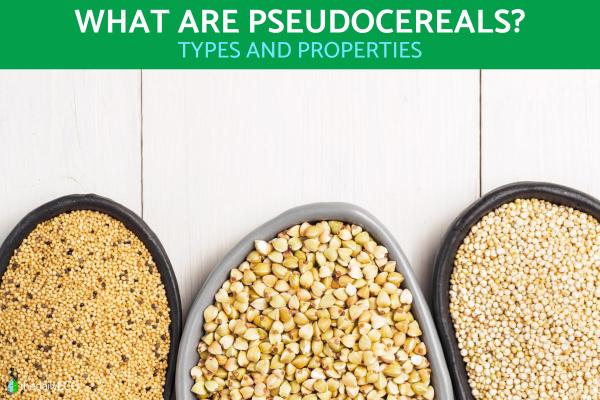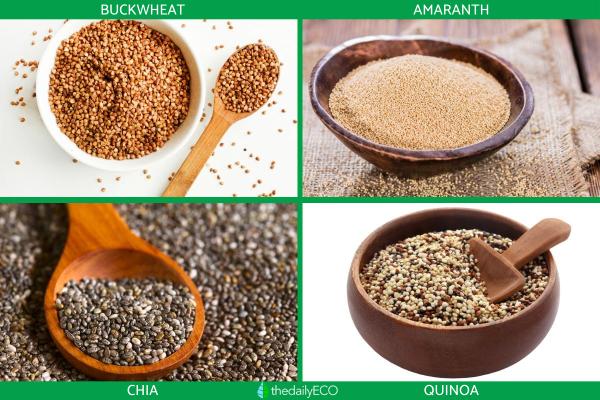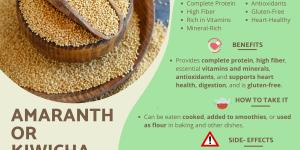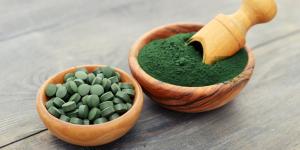What Are Pseudocereals or Psuedograins?


Pseudocereals are grains for human consumption that do not come from grasses. The majority of grains used in human food products are from the family of plants known as Poaceae. Grains from these grasses are known as cereal grains and are used in specific ways. One of the most common uses is being ground down to make flour. Pseudocereal grains are not from grasses, but they are used in similar ways in food preparation. This means they share certain properties, differentiating them from other non-grass crops. Some examples include chia, quinoa and amaranth.
We learn more at thedailyECO by asking what are pseudocereals or pseudograins? We look at the different types of pseudocereal, as well as what benefits they may have for human nutrition. We do so by comparing the differences between cereal grains and pseudocereal grains.
What are pseudocereals and their characteristics?
Pseudocereals are plants which are similar to cereals in terms of properties and uses, but which are not types of grass. This means they are not found in the plant family known as Poaceae. There are many plants used as food for humans, but which do are not considered pseudocereals. This is because pseudograins have properties which are very similar to regular cereal grains.
One of the most important properties of a pseudocereal is its relatively high carbohydrate content. They can also be milled into a flour, allowing them to be used in cooking and baking similar to cereal grains.
Unlike cereal grains, pseudograins are not very common in the modern diet. This has led some of them to be considered ‘ancient grains’. This is because they were once much more important in various ancient cultures, but their use was displaced by imported grains such as wheat. A recent rival in the use of ancient grains has made them more available to consumers, often extolling their various benefits.
Some of the most important characteristics of pseudocereals are:
- Lack of gluten: gluten is a protein common to various cereal grains to which many people are sensitive. For this reason, these traditional grains can be substituted with pseudocereals to make healthier recipes. Due to this absence of gluten, consuming pseudocereals may help reduce inflammation and improve the immune system.
- Essential amino acids: these are those that must be obtained externally because the body is not able to synthesize them sufficiently on its own.
- Protein: they are high in good quality protein, many even having complete proteins.
- Healthy fatty acids: also contain vitamins and complex carbohydrates in a high quantity.
- Low glycemic index: this makes pseudocereals more suitable for diabetics.
- High fiber content: helping to improve digestion.
- Hydrophilic: this means they attract water, in addition to storing it and expanding with it.
- Oxidize quickly: they should be stored properly and not left waiting for months to be consumed. Ideally, they should be stored in cold storage or in the refrigerator to extend their shelf life and maintain freshness.
Discover the importance of respecting dietary requirements with our article on the types of cross contamination in food preparation.
Examples of pseudocereals and their benefits
Buckwheat
It's one of the superstars of pseudocereals. Although its common name includes the word ‘wheat’, it is not related to true wheat (Triticum spp.). Instead of grasses, it is from the family of plants known as knotweed (Polygonaceae). Common buckwheat (Fagopyrum esculentum) is native to Asia and Europe.
Buckwheat has all the essential amino acids necessary for the human body, as well as B vitamins. It also contains a unique antioxidant called rutin. This may be useful as a potential anti-inflammatory agent, but research into its medicinal properties is insufficient.
Amaranth
This pseudocereal is native to Central America and Mexico. Pre-Hispanic cultures domesticated it for food, but its use has seen a resurgence in recent years.
In addition to being able to prepare it into flour, a nutritious sweet is made by coating the seeds with honey. This is sold as a popular candy in Mexico known as alegría. This name refers to one of this grain's qualities since the tryptophan it contains is a precursor to serotonin. It is also very rich in Omega 3, making it ideal for incorporating into vegan or vegetarian diets to supplement with this important fatty acid.
Learn more about the properties of this particular pseudocereal with our article asking what is the effect of amaranth on the body?
Chia
It is another American pseudocereal of great cultural importance. This was the basis of much of the pre-Hispanic diet and was also used in various rituals.
It's the queen of Omega 3 since it is the plant with the highest content of this fatty acid. It also has more calcium than milk. Its protein content is significant at 16%. It produces a mucilage when hydrated, acting as a form of fiber to regulate intestinal transit. This mucilage also helps provide a feeling of satiety.
In addition to chia, discover more about what are seeds with our related guide.
Quinoa
This pseudocereal is native to the Andes and was also domesticated to create a plant with high yields, but which is easy to tend and holds great nutritional value. As with chia seeds, quinoa was also used in rituals. It is now cultivated in several places in South America for commercial use, as there is significant market demand both inside and out of this continent.
They have the great benefit of being a complete protein, in addition to having a high overall protein level of 15%. They also contain all the essential amino acids. They are particularly high in lysine, which aids cognitive development.

What is the difference between pseudocereals and cereal grains?
We have already explained the basic difference between pseudograins and regular cereal grains, but we can understand these differences better by comparing the two:
- Grasses or not grasses: the main difference between pseudocereals and cereals is that they belong to different groups. Cereals are grasses, which means their seeds grow in spikes and are covered by a very thin layer. Pseudocereals belong to various different plant families.
- Nutrition: in terms of nutritional differences, we can say that pseudocereals provide more nutrients than traditional cereal grains. Many offer more protein and essential amino acids than others.
- Gluten: all pseudocereals are naturally gluten free, but most cereal grains do contain this structural protein. A common exception is corn which is a naturally gluten-free cereal grain.
Discover more about a relatively unknown cereal grain with our article asking what is Kamut?
If you want to read similar articles to What Are Pseudocereals or Psuedograins?, we recommend you visit our Healthy foods category.
- de Cangas Morán, R. (2023). The food matrix. Spain: ANAYA MULTIMEDIA.
- Campos-Rodriguez, J., Acosta-Coral, K., & Paucar-Menacho, L. M. (2022). Quinoa (Chenopodium quinoa): Nutritional composition and bioactive components of the grain and leaf, and the impact of heat treatment and germination. Scientia Agropecuaria, 13(3), 209-220.






